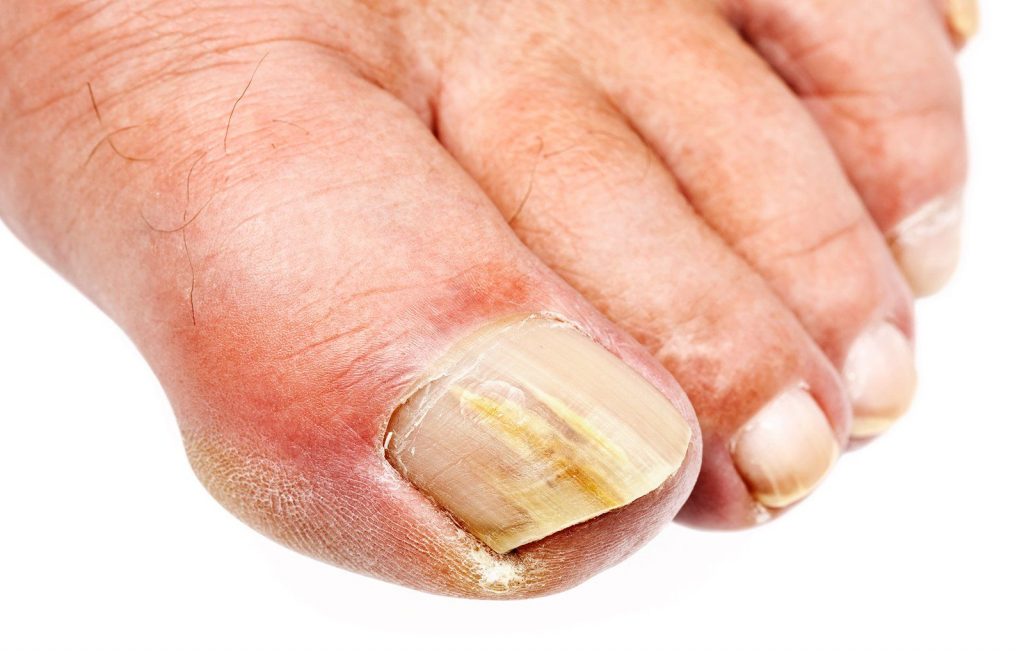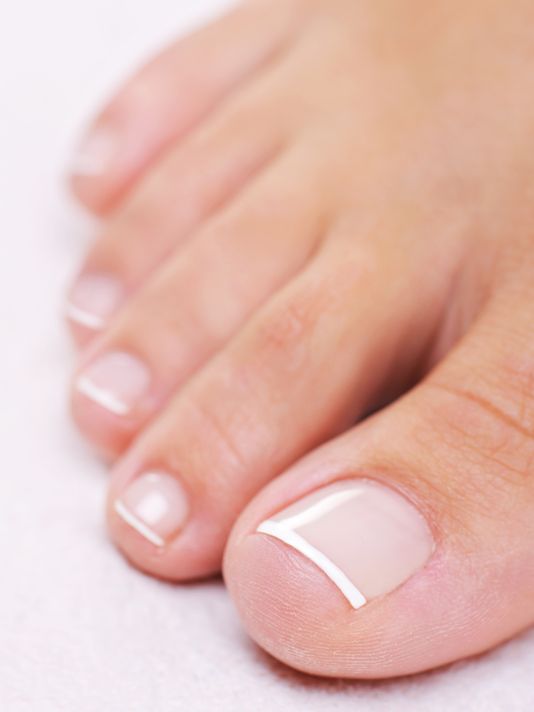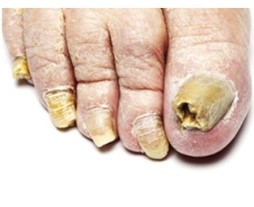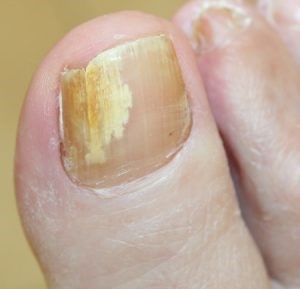Fungus toenail infections occur quite commonly in our population. The medical term for fungal nail infections is onychomycosis. Onychomycosis is a fungal infection of the fingernail or toenail, usually affecting the nail bed and the plate under the surface of the nail. A persisting fungal toe infection will require fungal nail treatment from a podiatrist. Podiatrists are specialised foot
doctors who can use a range of treatment options both at a foot fungus clinic and through home visits.

There are three main types of foot fungus: dermatophytes, yeasts and nondermatophyte moulds. In general, fungi are simple organisms that feed like a parasite from their environment, preferring dark, damp places.
The development of nail fungus can be quite slow, often being present for years without causing any noticeable problems or requiring a visit to the foot doctor. When patients do present to a Podiatrist nail fungus clinic, specialising in treating nail fungus, the toenail has typically become thicker with changes in colouring. Your podiatrist may be able to see yellow or brown discolouration, streaks or spots on the nail, crumbling of the nail or swelling around the nail area. Ingrown toenails or corns may have formed around the nail as a result and will require additional ingrown toenail treatment.
Diagnosis
To make an accurate diagnosis, your foot doctor will most likely take a small clipping of your nail and a sample from underneath the nail bed. This will be sent to the laboratory for analysis and culturing, ultimately determining exactly the type of nail fungus you have – essential when determining a treatment plan.
It is important to get a professional diagnosis from a podiatrist because fungal toenail infections can sometimes be confused with other conditions such as skin cancer or ingrown toenails. For example, ingrown toenails will typically cause swelling around the nail, leading to infection. The treatment for ingrown toenails would be quite different to the treatment required for fungal nail
infections. While the infection aspect is common to both conditions, it’s all about determining the underlying cause. Treatment of ingrown toenails typically requires surgery by a podiatrist to treat the underlying cause, whereas there are many other options for treating fungal nail infections.
Who gets toenail fungus infections and why do they occur?
Fungal nail infections can occur within any age group and affect both males and females. People with underlying immune conditions, diabetes or circulatory problems are particularly prone to infection, with occurrence more common in patients over 60. Nail biting, smoking, general poor health and trauma to the nail can also increase your predisposition.
The type of footwear you wear and the environment your toenail lives in are also significant factors. For example, a podiatrist on the Sunshine Coast in Queensland would take into consideration if you normally wear a closed or open shoe when developing a treatment plan for toenail fungus. On the one hand, open shoes can be good for keeping our feet dry and allowing
the nail to stay dry in the fresh air, while on the other closed shoes can offer more support for other conditions such as foot or heel pain. A balanced approach is needed for comprehensive fungal nail treatment.
Likewise, a podiatrist in Noosa or a foot doctor in Noosaville might ask you about how often you go to the beach or go swimming. Behind their questions is the need to understand if your feet are regularly wet and damp. They will also be very interested in the type of shoes you wear. If you are visiting a podiatrist in Noosa or Noosaville, chances are you spend a lot of time in
thongs or open shoes in your recreational time. However, while you are at work you may spend time in tight, poorly fitted, closed in shoes with poor ventilation which cause your feet to sweat, providing a damp and welcoming environment for fungi. Mitigating against damp feet is important in preventing toenail fungus.
When to seek treatment
If you have been persisting with home treatment approaches for a number of months and signs of the infection keep recurring, then it is time to go and see a specialist foot doctor. Telltale signs could include recurring white marks on the surface of your nail – despite you filing them off, or a persisting smell.
You should visit a podiatrist when you notice any discolouration, thickening or deformity of your nail. Podiatrists are accessible at many locations on the Sunshine Coast including, Noosa, Noosaville and Gympie to the west.
What are the treatment options?
There are a number of treatment options your podiatrist might recommend for the treatment of fungal nail infections. Treatment can sometimes be difficult and the fungus is not always able to be eradicated, resulting in the need for ongoing management to relieve symptoms.
Topical
Topical therapy is used to treat the mildest cases of fungal nail infection. Some topical treatments are available off the shelf or through your pharmacist. However, treatment is more effective with an accurate diagnosis from a podiatrist.
Oral
Oral antifungals can be very effective, especially as a targeted treatment for a new infection. Treatment usually requires a course of oral medication over a number of weeks. Side effects can include an upset stomach. Care needs to be taken when using oral antifungals for treatment over the long term as liver toxicity can sometimes occur. Oral antifungals should not be confused with oral antibiotics used in the treatment of infections in ingrown toenails.
Debridement
A small surgery referred to as debridement, is sometimes used in the treatment of nail fungus infections. It is a small procedure, usually done in the rooms at the foot fungus clinic, which involves cutting or thinning the nail. The procedure is painless – no worse than going for a pedicure. In more severe cases the whole nail may be removed under local anesthesia.
Thermal laser
Thermal laser treatments work by using heat to destroy the fungal cells beneath the nail plate. While this treatment is effective, the heat from the laser is not always well-tolerated.
Cold laser
Cold laser is a relatively new treatment for nail fungus and can be undertaken at a fungal nail clinic. It is painless, quick and drug-free with a reported 95% success rate. Through a combination of lower wavelengths, the fungus is treated and tissue rejuvenation is stimulated. A number of treatments are required with results becoming evident upon new nail growth. The Lunula Laser is only offered by a small group of podiatrists. Suncoast Podiatry has introducedLunula Laser to the Sunshine Coast and is currently the only podiatrist on the Sunshine Coast to offer this treatment.
If you are interested in any of these treatments please book an appointment to have your nails fixed up and your nails should look like this in no time.

Prevention is always the best strategy. There are a few simple things you can do at home to prevent fungal nail infections including, keeping your toenails short, filing down any thick areas, thoroughly drying your feet and nails ( including the areas between your toes), using a separate pair of nail scissors or clippers to trim infected toes, avoid wearing nail polish on your toes and
wearing protective shoes or sandals in public showers.
If you do suspect you have a fungus nail infection, despite your best efforts at prevention, come and see us at one of our fungal nail clinics. Our podiatrists are highly skilled and experienced in the treatment of fungal nail infections. The earlier you come to see us, the better the chance of successful treatment. There is no need to feel embarrassed or frightened. At our fungal nail clinics, we see fungal nail infections all the time and will talk to you about your options before starting any treatment.
Contact us to arrange an initial consultation:


